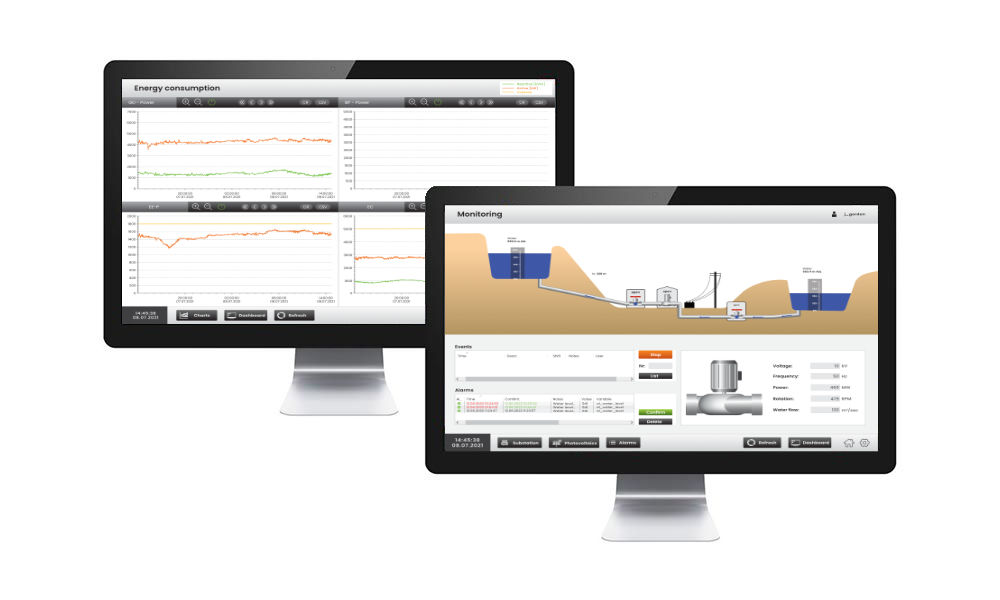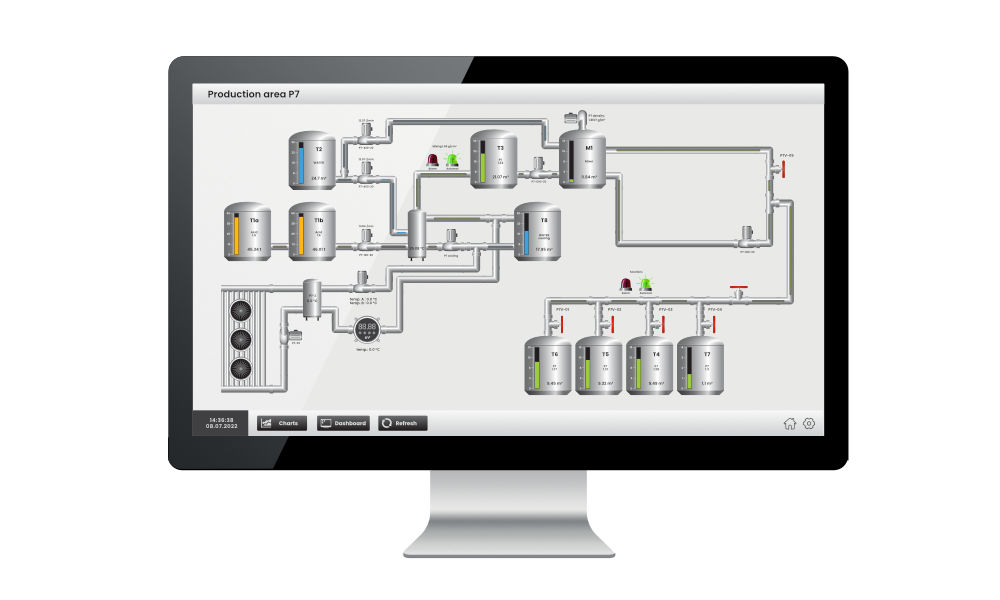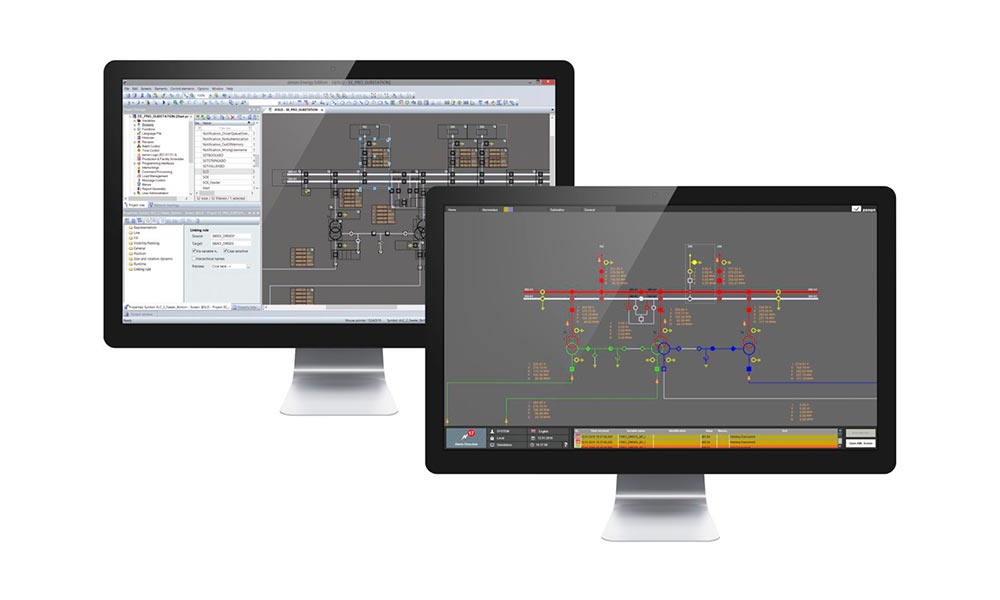
SCADA System
Within the scope of comprehensive IT solutions designed for production companies, Quantum also provides its clients with SCADA-class software (Supervisory Control And Data Acquisition software). The SCADA software offered by Quantum provides solutions supporting supervision of production process that have been well tested in several dozen countries, in thousands of installations. The software supports such industry branches as automotive, chemical, food, pharmaceutical or power industries, among others. Thanks to its versatility and universal character, the SCADA solutions provided by Quantum may easily be integrated with industrial instrumentation and control solutions already implemented in particular plants.
Data collection
A SCADA-class system systematically acquires and archives all the data related to production progress, including data related to the quantity of manufactured goods, their quality as well as parameters of the production process itself. The system acquires data thanks to its integration with sensors, control and measurement modules and PLC controllers of machines. The software allows one to replace traditional data acquisition methods, such as hard copy documentation.
Graphic visualization of processes
Visualizations of process progress that are updated in real time provide users with all the information that is needed during plant operation. The visualizations are profiled by the system to suit the needs of particular work posts, e.g. a machine operator, a supervisor, a production manager. To managers and supervision officers, the system offers a complete and easy-to-interpret overview of the functioning of an entire production shop. This ensures full control over production processes and the possibility of fast reaction in any situation whatsoever.
Supervisory control
SCADA software is capable of two-way communication with production machines. Thus, in case any irregularities should occur in production processes or deviations from assumed standards should be detected (SPC – Statistical Process Control), the system is able to automatically put the relevant machine out of operation. This, in turn, allows major failures and unnecessary consumption of materials and energy to be avoided.
Support for maintenance ensuring process continuity
The SCADA system provides up-to-date information about the condition of machines, their current operations, stoppages and productivity levels. In case a machine failure should occur, the system shall automatically report this fact to appointed persons and identify the affected machine component, which accelerates considerably failure diagnostics and allows maintenance services to get prepared better for remedial actions. The SCADA system is the key component for the predictive maintenance method that allows servicing works to be based on the actual condition of machines, and not on a fixed schedule of overhauls and maintenance works.
Examples of screens
Process simulation
As the SCADA software is equipped with tools for production process simulation, the result of changes planned in the system may be known even before they have actually been implemented. Thus, change management becomes easier and it becomes possible to compare alternative scenarios, which creates new opportunities for production process optimization that have never been available before.
Advanced reports and analyses
The SCADA system generates detailed production balance-sheets and reports. They allow assessment of production department operation to be based on actual data acquired from machines, and not only on operators’ declarations. The system calculates automatically the crucial productivity coefficients relevant for a company – including OEE, MTBF, MTTR – and does so in real time. Balance-sheets available in the system facilitate comparative analyses of particular work stations and production lines, prediction of main sources of failures and defects, as well as analysis of resources consumption. The SCADA software is equipped with tools for predictive analyses that allow one to predict, for instance, how a given change in the production process is going to translate into electric energy consumption.
Flexibility and simplicity of use
The SCADA software supports over 300 communication protocols, which facilitates considerably its cooperation with a variety of devices implemented in plants. Having numerous and intuitive wizards at his/her disposal, the user may carry out independently numerous tasks, without any need for specialized software development. Easy setup and configuration, in turn, allows the system to be quickly adapted to the needs of any type of production, be it piece/job production, series or batch production.
SCADA System – its functions and capabilities
- registering and reporting of effectiveness of machines and equipment;
- recording of defective products, materials consumption, downtimes and changeover times;
- visualization of production and technological processes;
- statistical process control (SPC);
- communication with machines via PLC controllers or control and measurement modules;
- machine condition monitoring, alerting about downtimes, failures and defects;
- digital document flow;
- cooperation with ERP and MES software and with HMI panels;
- simulation of production processes, predictive analyses;
- automatic calculation of KPIs: OEE, MTBF, MTTR;
- conformity with standards: ISO 50001, IEC 61131-3, ISA-88, ISA-95, FDA 21CFR part 11.
Process simulation
As the SCADA software is equipped with tools for production process simulation, the result of changes planned in the system may be known even before they have actually been implemented. Thus, change management becomes easier and it becomes possible to compare alternative scenarios, which creates new opportunities for production process optimization that have never been available before.
Advanced reports and analyses
The SCADA system generates detailed production balance-sheets and reports. They allow assessment of production department operation to be based on actual data acquired from machines, and not only on operators’ declarations. The system calculates automatically the crucial productivity coefficients relevant for a company – including OEE, MTBF, MTTR – and does so in real time. Balance-sheets available in the system facilitate comparative analyses of particular work stations and production lines, prediction of main sources of failures and defects, as well as analysis of resources consumption. The SCADA software is equipped with tools for predictive analyses that allow one to predict, for instance, how a given change in the production process is going to translate into electric energy consumption.
Flexibility and simplicity of use
The SCADA software supports over 300 communication protocols, which facilitates considerably its cooperation with a variety of devices implemented in plants. Having numerous and intuitive wizards at his/her disposal, the user may carry out independently numerous tasks, without any need for specialized software development. Easy setup and configuration, in turn, allows the system to be quickly adapted to the needs of any type of production, be it piece/job production, series or batch production.
SCADA System – its functions and capabilities
- registering and reporting of effectiveness of machines and equipment;
- recording of defective products, materials consumption, downtimes and changeover times;
- visualization of production and technological processes;
- statistical process control (SPC);
- communication with machines via PLC controllers or control and measurement modules;
- machine condition monitoring, alerting about downtimes, failures and defects;
- digital document flow;
- cooperation with ERP and MES software and with HMI panels;
- simulation of production processes, predictive analyses;
- automatic calculation of KPIs: OEE, MTBF, MTTR;
- conformity with standards: ISO 50001, IEC 61131-3, ISA-88, ISA-95, FDA 21CFR part 11.
Contact Form
Company
Contact
- +48 (12) 646 98 00
- +48 (12) 646 98 02
- info@quantum-software.com
- quantum-software.com



